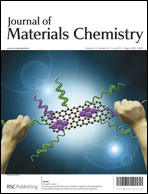Adhesion enhancement of ink-jet printed conductive copper patterns on a flexible substrate†
Abstract
Ink-jet printed conductive copper patterns with enhanced substrate adhesion were fabricated using a conductive copper ink containing a silane coupling agent as an adhesion promoter. The effect of the silane coupling agent on the copper complex ion ink properties, including viscosity and surface tension, was systematically investigated. The copper complex ion ink that was ink-jet printed on a polyimide film was transformed to copper films by thermal treatment at 200 °C for 2 h in H2. The phase, microstructure, resistivity and peel strength were examined by X-ray diffraction, field emission scanning electron microscopy, the four-point probe technique, the 90° peel test and the ASTM D3359 tape test. The proper amount of silane coupling agent was determined according to the electrical conductivities and adhesive strengths of the ink-jet printed copper patterns containing varied amounts of adhesion promoter. As a result, the patterns formed from copper complex ion ink containing 3 wt% silane coupling agent exhibited not only the highest peel strength (240.3 gf mm−1 and 4B) but also low resistivity (approx. 20 μΩ cm). The mechanism of adhesion promotion via the silane coupling agent was also suggested.


 Please wait while we load your content...
Please wait while we load your content...